Gut reaction: You won’t want to hide the HTC U11 in a protective case. HTC’s new flagship phone is just too stunning to conceal behind a chintzy polycarb shell. Imbued with HTC’s new “liquid” design aesthetic, the U11 has an impossibly glossy finish, evoking the T-1000 Terminator for those old enough to remember that robot assassin.
From a basic specs perspective, the U11 is a solid but not remarkable Android 7.1 phone. It includes a state-of-the-silicon-art Snapdragon 835 processor running up to 2.45 GHz, a 3,000 mAh battery, a 5.5-inch quad HD (2560×1440) display. That’s right: HTC’s Super D 5 display has a traditional 16:9 aspect ratio, remaining resolutely old-school while Samsung are embracing taller 18:9 aspect ratio displays.
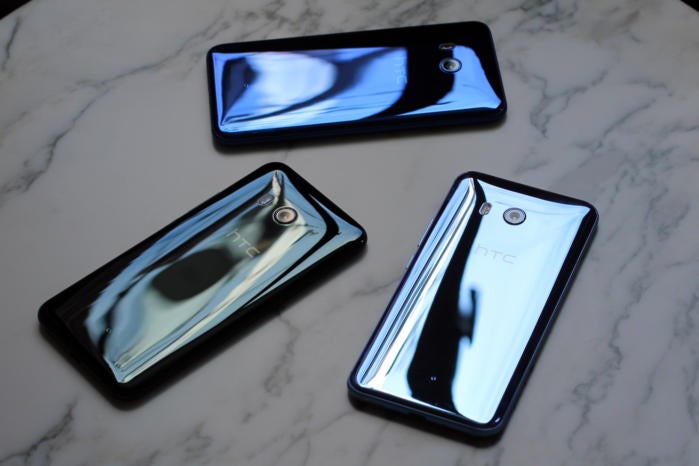

A third-generation 12-megapixel Ultraxel camera graces the back of the U11. The glass shell is stunning, but requires constant attention to buff away fingerprints.
Nonetheless, the U11 still includes a number of surprise–delight features that could attract both hardcore HTC enthusiasts, as well as less tech savvy consumers who take the time to consider the phone’s unique bag of tricks. Besides its curiosity-piquing design, the U11 includes Amazon exa support, a new way to launch apps features, better-than-ever audio from a phone line-up that’s always pushed the audio envelope.
HTC’s liquid design
first saw HTC’s liquid design in the U Ultra, a 5.7-inch phone that’s seen limited release in the United States. ly, we don’t like the U Ultra very much. Among other issues, its body, while stunning, also attracts a lot of fingerprints. And my colleague feels the U Ultra is just too slippery.
I never went hs-on with the U Ultra, but I’ll concur that the U11’s back panel is a fingerprint magnet. That said, the new flagship U11 never felt particularly slippery in my hs, I’m wowed by its reflective shine.
The U11 looks like liquid metal, but its back panel is actually made of Gorilla Glass. Three U11 colors will come to the U.S.—Sapphire Blue (dark blue), Amazing Silver (light blue) Brilliant Black (black). The two blue models are particularly gorgeous, sans fingerprints, all three colors cast reflections with more drama than you’ll find in any other phone.
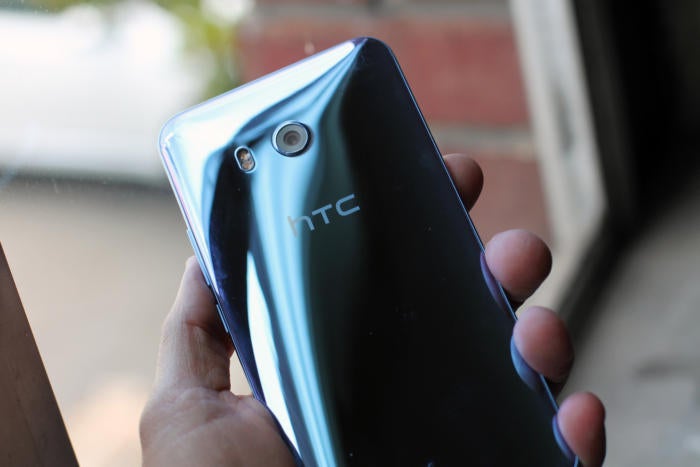

HTC told me the U11’s color is added to the inside of the Gorilla Glass, ensuring the color won’t be scratched off if you nick the back panel. This is important because the back panel is made from Gorilla Glass 3, which is tuned for superior impact resistance, but not necessarily scratch resistance. Notably, the glass shell has what HTC calls “3D” edges: Curved edges that are bent in progressive stages during the manufacturing process to improve stiffness.
The glass that protects the display is also 3D Gorilla Glass—Gorilla Glass 5, which is stronger. In between the two pieces of glass is a strip of aluminum that forms a b around the entire body. In all, the phone is decidedly stiff, I couldn’t make it bend when torquing the body with steady pressure on opposing side. HTC told me they worked hard to refine the tolerances among the three parts of the body, indeed, it all feels like a solid unibody phone.
Amazon exa ge Sense
The U11 boasts four microphones: two on the top bottom edges, two front back. One of the mics is always on for voice prompts, this is where HTC gets crafty. The phone’s Snapdragon 835 processor offers silicon-level support for not one, but two wake words. So, while most Android phones will respond to just a single wake phrase—“OK ” to launch Assistant—the U11 has been engineered to also wake to “exa,” thus opening the door to Amazon’s exa universe.
If you already use an Amazon Echo or Echo Dot, you can imagine the usefulness of having a phone that can turn on your lights control other exa ecosystem features. But there are two caveats. First, HTC says the U11 won’t get the exa app until about a month after the phone is released in the U.S. Second, not all exa features will be available once the exa app is automatically pushed to the phone.
HTC wouldn’t provide any details on which exa features will (or won’t) be available at the onset, but said the goal is for the U11 to become a full-fledged member of the exa device family.
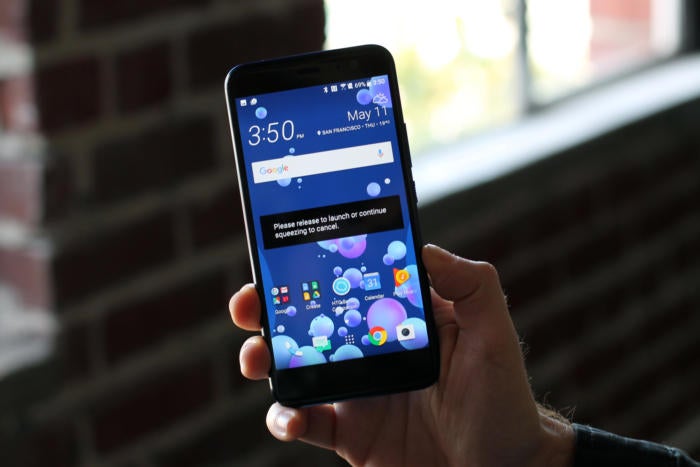

ge Sense activates apps features with a squeeze.
ile you’re waiting for exa support to materialize, you can familiarize yourself with ge Sense, which launches various functions from a locked phone with either a short or long squeeze of the chassis.
For example: Give the body of the phone a quick squeeze you’ll go straight from a dark, locked screen to the camera app. Squeeze quickly again, the phone will take a picture. Or give the phone a long squeeze. This turns on flashlight mode. Then you can long-squeeze the U11 again to turn the flashlight off.
But those are just examples. You can set up the U11 for two ge Sense actions, there’s a variety of options to choose from. ge Sense can launch the camera; turn the flashlight on off; launch Assistant; launch HTC Companion (the company’s own AI assistant); take a screenshot; turn -Fi on off; or launch any app of your choosing.
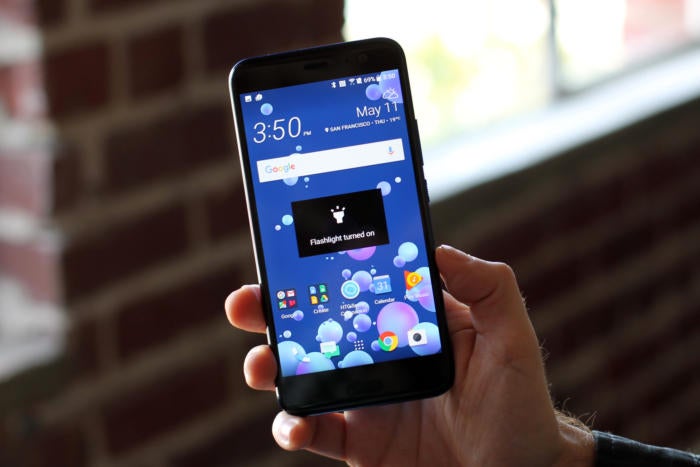

The phone is rated for I7 water resistance, so ge Sense will still work if the U11 gets wet. It will also work if you’re wearing gloves, if the U11 is sitting inside a case (though the case will need a degree of flex). You can also set force levels for how hard you need to squeeze before ge Sense activates.
As far as unlocking the phone, you can use voice unlock, facial recognition, or a fingerprint sensor built into the capacitive home button. But unlike the new Samsung Galaxy S8, the U11 doesn’t include an iris scanner.
Next-generation BoomSound
My first Android daily driver was the HTC One M8, a phone I particularly liked for its loud BoomSound speakers located on the front of the phone, directly adjacent to the display. This came in hy for speakerphone calls. HTC has since moved its speakers to the top bottom edges of its phones, but BoomSound sounds better than ever in the U11.
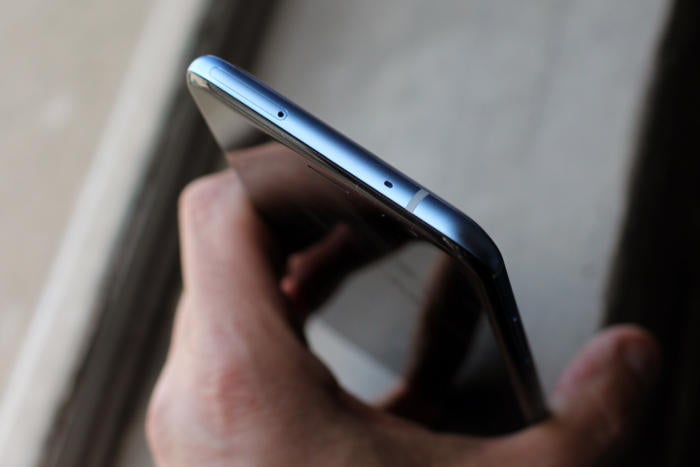

In A/B testing with the HTC 10, the new U11 sounded both louder more vibrant, with superior dynamic range. HTC is also bundling a new version of its BoomSound onic headphones, which I thought sounded fantastic when I went hs on the the HTC Bolt. The new headphones still include Adaptive Audio, which creates a unique sound profile that’s customized to your hearing. But in this generation of headphones, HTC adds active noise cancelling, drawing power from the B-C port to which it’s connected.
Concerned about legacy headphones? ll, HTC is including a 3.5-inch-to-B-C adapter in the box. So you can use your headphones with a dongle, but you can’t charge listen at the same time. You’ll also get a clear protective case for the phone if you’re really worried about fingerprints.
Cameras, HTC Companion final impressions
For the U11, HTC made a modest upgrade to its rear camera sensor, improving aperture size to f/1.7 from f/1.8. The camera remains 12 megapixels, but employs HTC’s Ultraxel technology with large 1.4 micron pixels. The upshot is that while other cameras may have more megapixels, HTC’s megapixels capture relatively more data thanks to their larger size. Note that this is not the unique feature it once was: Some competing phones (like the Galaxy S8) also have 1.4 micron pixels. You also get an option to record 24-bit audio during video shoots, even 3D audio thanks to the phone’s four mics.
On the front of the U11, the selfie camera is 16 megapixels, boasts an f/2.0 aperture with a 150-degree field of view.
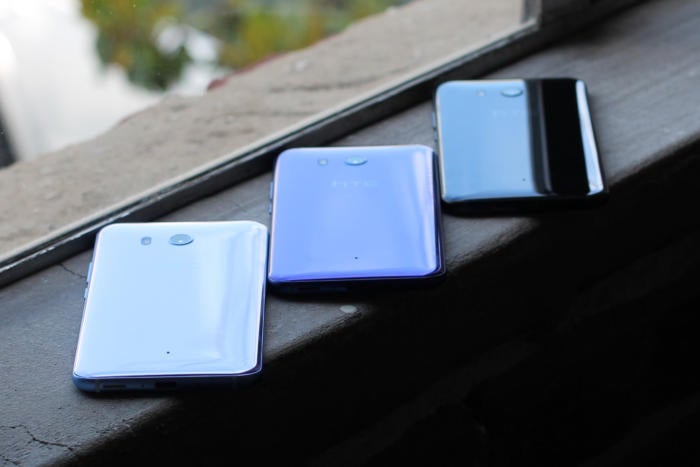

In terms of software, HTC continues to deliver a user interface that only modestly customizes the basic Android experience— that’s awesome. Chrome is the default browser, ay Music is the default music player, in general the HTC skin is simple unobtrusive. This alone may push people toward HTC away from Samsung.
The U11 also includes HTC Companion, an AI assistant that helps you improve your basic ownership experience.
For example, Companion may notice that you have a busy calendar schedule after 6 pm, remind you to charge your phone in the afternoon so you’ll have enough battery for those events. HTC Companion will also track your app usage, ask you if you’d like to optimize battery life for the apps you use most.
In all, the U11 seems to be a very calculated targeted phone. It may not offer the kitchen sink of features that come with the Galaxy S8, but the features it does include could really resonate with select target users. ke the Amazon exa addict. Or the person who dems a simple software experience. Or maybe even the person who’s looking for noise-cancelling headphones, wouldn’t mind getting them for virtually free.
The U11 will be available in two configurations: 4GB RAM with 64GB of storage, 6GB of RAM with 128GB of storage. Here in the U.S., only the 4GB/64GB version will be sold. And you can also add more storage capacity via a microSD card slot. icing availability is TBD, we’ll update this story as soon as we know.


















